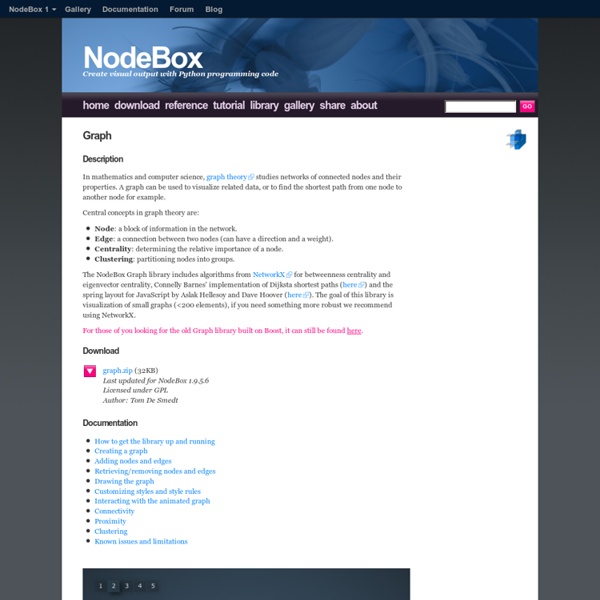Graphviz | Graphviz - Graph Visualization Software
19.5. xml.parsers.expat — Fast XML parsing using Expat — Python v2.7.1 documentation
Warning The pyexpat module is not secure against maliciously constructed data. If you need to parse untrusted or unauthenticated data see XML vulnerabilities. New in version 2.0. The xml.parsers.expat module is a Python interface to the Expat non-validating XML parser. This module uses the pyexpat module to provide access to the Expat parser. This module provides one exception and one type object: exception xml.parsers.expat.ExpatError The exception raised when Expat reports an error. exception xml.parsers.expat.error Alias for ExpatError. xml.parsers.expat.XMLParserType The type of the return values from the ParserCreate() function. The xml.parsers.expat module contains two functions: xml.parsers.expat.ErrorString(errno) Returns an explanatory string for a given error number errno. xml.parsers.expat.ParserCreate([encoding[, namespace_separator]]) Creates and returns a new xmlparser object. encoding, if specified, must be a string naming the encoding used by the XML data. 19.15.1. 19.15.2.
Flare | Data Visualization for the Web
Python API Tutorial for AllegroGraph 4.0
This is an introduction to the Python client API to AllegroGraph RDFStore™ version 4.2 from Franz Inc. The Python Sesame API offers convenient and efficient access to an AllegroGraph server from a Python-based application. This API provides methods for creating, querying and maintaining RDF data, and for managing the stored triples. The Python Sesame API deliberately emulates the Aduna Sesame API to make it easier to migrate from Sesame to AllegroGraph. Contents Overview Return to Top The Python client tutorial rests on a simple architecture involving AllegroGraph, disk-based data files, Python, and a file of Python examples called tutorial_examples_40.py. Each lesson in tutorial_examples_40.py is encapsulated in a Python function, named exampleN(), where N ranges from 0 to 21 (or more). Prerequisites (Linux) Return to Top The tutorial examples can be run on a Linux system, running AllegroGraph and the examples on the same computer ("localhost"). Terminology Return to Top WebView
jquery - Graph visualization code in JavaScript
PyAIML (a.k.a. Program Y) - A Python AIML Interpreter
Data Visualization Software Lab - Data visualization JavasScript library for adding interactive touch-screen driven charts and graphs to your web site (Javascript and HTML5 SDK)
Creatures | City in a Bottle
Cytoscape.js
This is how easy it is to get started with Cytoscape.js (this code creates the instance you see on the bottom-right: About Cytoscape.js is an open-source graph theory library written in JavaScript. Cytoscape.js allows you to easily display and manipulate rich, interactive graphs. Cytoscape.js also has graph analysis in mind: The library contains a slew of useful functions in graph theory. Cytoscape.js is an open-source project, and anyone is free to contribute. The library was developed at the Donnelly Centre at the University of Toronto. Cytoscape.js & Cytoscape Though Cytoscape.js shares its name with Cytoscape, Cytoscape.js is not Cytoscape. Cytoscape.js is a JavaScript library: It gives you a reusable graph widget that you can integrate with the rest of your webapp with your own JavaScript code. Funding Funding for Cytoscape.js and Cytoscape is provided by NRNB (U.S. ISB | UCSD | MSKCC | Pasteur | Agilent | UCSF | Unilever | Toronto | NCIBI | NRNB Architecture & API Notation Position Data
trendrr/whirlwind - GitHub
Processing.js
Demos below! As a sort-of reverse birthday present I’ve decided to release one of my largest projects, in recent memory. This is the project that I’ve been alluding to for quite some time now: I’ve ported the Processing visualization language to JavaScript, using the Canvas element. I’ve been working on this project, off-and-on now, for the past 7 months – it’s been a fun, and quite rewarding, challenge. The Processing Language The first portion of the project was writing a parser to dynamically convert code written in the Processing language, to JavaScript. It works “fairly well” (in that it’s able to handle anything that the processing.org web site throws at it) but I’m sure its total scope is limited (until a proper parser is involved). The language includes a number of interesting aspects, many of which are covered in the basic demos. Note: There’s one feature of Processing that’s pretty much impossible to support: variable name overloading. The Processing API Download How to Use Demos
bayesian-inference - Project Hosting on Google Code
This package is a collection of useful classes for basic Bayesian inference. Currently, its main goal is to be a tool for learning and exploration of Bayesian probabilistic calculations. Currently it also includes subpackages for stochastic simulation tools which are not strictly related to Bayesian inference, but are currently being developed within BIP. The Subpackage Bayes also offers a tool for parameter estimation of Deterministic and Stochastic Dynamical Models. Coelho FC, Codeço CT, Gomes MGM (2011) A Bayesian Framework for Parameter Estimation in Dynamical Models. To install, download the latest version from this page, unpack and follow instructions on README file. I hope that in time it will mature into an useful tool for general use.



